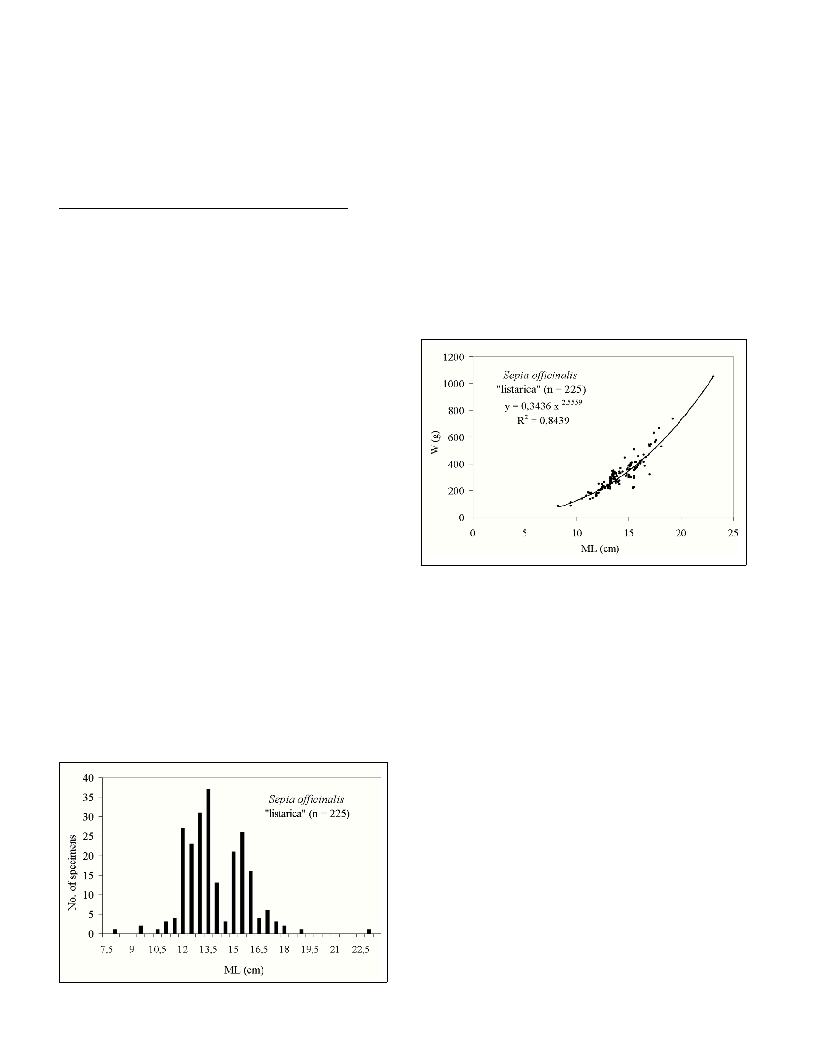SEPIA OFFICINALIS L. IN THE COMMERCIAL TRAMMEL NET CATCHES
IN THE NORTH ADRIATIC IN AUTUMN-WINTER
I. Jardas*, P. Cetinic, J. Dulcic, M. Kraljevic, S. Matic Skoko, A. Pallaoro, A. Soldo
Institute of Oceanography and Fisheries, Split, Croatia - * jardas@izor.hr
Abstract
Sepia officinalismade 7.1% and 11.7 % of the total commercial trammel net catches in the North Adriatic during autumn-winter. Mantle
length ranged from 8.2 to 23.2 cm (mean = 13.9 ±1.83 cm) and weight from 84.0 to 1,054 g (mean = 300.7 ±115.8 g). Two dominant
length classes were identified. The value of the exponent bof the length-weight relationship was 2.5559.
Keywords: cuttlefish, trammel net catches, North Adriatic
Rapp. Comm. int. Mer Médit., 37,2004
373
Introduction
Generally, cuttlefish, Sepia officinalis, is east Atlantic and
Mediterranean demersal, neritic species occurring predominantly on
sandy and muddy bottoms from the coastline to about 200-250 m
depth, but most abundant in the upper 100 m (1, 3-6). It is one of the
most abundant Adriatic cephalopod species, occurring in the catches
of different inshore and offshore fishing gears all over the year (1-3),
particularly in warmer months (1, 2) and at depths less than 60 m (2,
3). Seasonal offshore-inshore (vertical) migrations have been reported
for both Mediterranean and Adriatic stocks (1, 3, 5, 6). In early spring,
Adriatic individuals leave deeper water, where they spent the winter at
50-60 m depth, to migrate into shallower ones (10-30 m) for spawning
(in April-July). The North Adriatic is one of the most important
cuttlefish fishing areas (1).
This study deals with commercial trammel net (“listarica”) fishing
in the North Adriatic during autumn-winter in respect of quantitative
participation, length frequency distribution, age, and length-weight
relationship of cuttlefish in the catches.
Material and methods
Samples were collected during December 2002 and January-
February 2003 from 51 commercial trammel net (so-called “listarica”,
operating only in North Adriatic, for fishing Solea) catches (6,057 nets
were used) in the North Adriatic over an area of 410 km
2
along the
west Istrian Peninsula north of 45
o
23’, Lovrecica Cove, to the
territorial sea frontier in Piran Bay and at depths down to 30 m. The
construction characteristics of the trammel nets were: length 18-20 m,
depth up to 1 m, mesh bar length of external and internal panels 160
and 40 mm respectively. Overall, 225 specimens were analysed.
Mantle length (ML) was measured to the nearest 0.1 cm and weight to
the nearest 1 g. The commonly used length-weight relationship was
applied: W= a(ML)
b
. Age was determined on the basis of length
frequency distribution.
Results and discussion
Overall, 48 fish, 5 edible crustacean (Stomatopoda, Decapoda) and
3 cephalopod species were identified. Two species dominated the
catches, both in terms of numbers and weight (W): common sole
(70.9% and 70.4%) and cuttlefish (7.1%, and 11.7%). CPUE (catch
per one net) was No ind. = 0.82 and W= 0.17 kg for whole catch, No
ind. = 0.58 and W= 0.12 kg for common sole, and No ind. = 0.06 and
W= 0.02 kg for cuttlefish. Consequently, low fishing efficiency of
“listarica” trammel nets in relation to cuttlefish was established.
CuttlefishMLand weight ranged from 8.2 to 23.1 cm (mean
= 13.9 ±1.83) (Fig. 1) and from 84 to 1,054 g (mean = 300.7 ±115.1 g).
The slope (value b) of the length-weight relationship (Fig. 2) was
b= 2.5559 (SE
b
= 0.073) and differed significantly from 3 (t-test,
= 7.15, t
crit
= 2.576, p< 0.05), as it has been reported in previous
studies (2, 4), indicating negative allometric growth.
The MLfrequency distribution exhibited two main modes: at 13.5
and 15.5 cm.
Fig. 2. Sepia officinalis:Length-weight relationship.
References
1-Grubišic F.,1988. Fishes, crustaceans and bivalves of the Adriatic.
Naprijed, Zagreb, 239 p. (in Croatian).
2-Jardas I., Pallaoro A., Cetinic P., Dulcic J., 2001. Cuttlefish, Sepia
officinalisL., in the trammel bottom set catches along the Eastern Adriatic
coast (Croatia). Rapp. Comm. int. Mer Médit., 36: 277.
3-Mandic S., Stjepcevic J., Dragovic R., 1982. Migrations of some
cephalopod species in the South Adriatic. Stud. Mar. Kotor, 11-12: 95-101
(in Croatian).
4-Manfrin Piccinetti G., Giovanardi O., 1984. Données sur la biologie de
Sepia officinalisL. dans l’Adriatique obtenues lors des expéditions Pipeta.
FAO Rap. Pêches, (290): 135-138.
5-Mangold K., Boletzky S. v., 1987. Cephalopodes. Pp. 633-714. In:
Fischer W., Bauchot M.-L., Schneider M. (ed.), Fiches FAO
d’identification des espèces pour les besoins de la pêche. Méditerranée et
mer Noire, 1. FAO, Rome.
6-Roper C.F.E., Sweeney M.J., Nauen C.E., 1984. FAO species
catalogue. Vol. 3. Cephalopods of the world. FAO Fish. Synop., (125), Vol.
3: 277.
Fig. 1. Sepia officinalis:Length frequency distribution.

